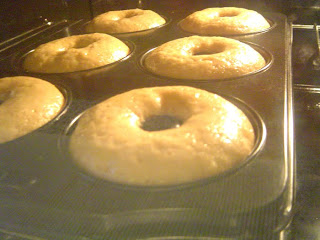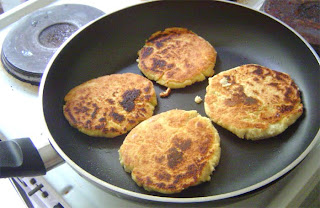Per request of a very monstrous (but harmless and adorable) creature with noodle on the back, I'm posting this not-very-Berlin-way vegan recipe...
This summer is indeed a hot summer! It roared up to 38°C yesterday, good thing that I saw clouds drifting over to rescue my apartment, which is situated on the top of the apartment floor, making the ceiling heat up in the scorching sunlight and radiating me in the night like a human-oven.
Chinese eat a lot of different types of noodle, not just differ in thickness, but in the type of floor it is made of, amount of oil, freshly made (damp noodle) and dried, and of course, the way of indulging them (eating it cold or hot, eating it in soup or dried, eating it with sauce or with garnish only, sauté in hot pan...)
Taiwan has this local specialty of noodle that's called 油麵 (literal translation would be "oil noodle"). The noodle it self doesn't seem that much different from other types of noodle, except it looks round, not too thin (about 2 mm) and has a faint hint of yellow. It is made
WITHOUT OIL. It is made with
high gluten wheat flour, which gives it the texture of smooth and chewiness, and the noodle doesn't stick to each other as easily. This is the real reason why it is called oil noodle, not because it is made of oil, but the high gluten wheat flour that gives it the characteristics of not sticking together.
Taiwan yu-mien (oil noodle) by a Hong Kong-nese noodle company
Being in Berlin, I could find all the ingredients in an Asian supermarket chain called "Amazing Oriental" on Kanstraße opened up by Hong Kong-nese, originated from the Netherlands:
Kantstraße 101, 10627 Berlin
I don't think you can get all the ingredients in other Asian markets in Berlin, because other markets are opened by Vietnamese-Chinese (they are mainly Cantonese), Thai or perhaps Korean, and these ingredients are too real Asian to be sold else where.
Usually this type of noodle is sold fresh, meaning it is freshly made and without drying process, sold in traditional markets in Taiwan. But now that I've left Taiwan for so long and now in a country without too much connection to Taiwan, I could only find dried ones from Hong Kong. The label says: "Taiwan oil noodle" but I read the company information, it is a Hong Kong company. (disappointed)
This noodle is used for making 台式涼麵 tai-shi liang-mien (literal translated to "Taiwan cold noodle"), I assure you, it tastes different with other types of noodle.
The sauce is basically made with:
BLACK sesame paste (Middle Eastern and Westerners only know of the white sesame)
peanut butter
黑醋 hei-tsu (or hei1 cu4, literal translated to "BLACK vinegar," I only know of Taiwan people use this)
米醋 mi-tsu (or mi2 cu4, literal translated to "rice vinegar," Chinese, Korean and Japanese all use this, other vinegars don't have a "zing" like rice vinegar does, try it, you'd know what I'm talkin' about!)
soy sauce
sugar
sesame oil
The tricky part is getting this ratio exactly right to make your sauce for the tai-shi liang-mien.
The pure black sesame paste, rice vinegar, organic soy sauce and sesame oil
When you get sesame oil, try to get the ones from Taiwan, Japan or Korea, these origins produce their own sesame seeds for the oil. I've tried one from Hong Kong, it really didn't have the "zing" in the sesame oil and isn't as aromatic as the others.
Tai-Shi Liang-Mien Jiang (or "Taiwan Cold Noodle Sauce")
Preparation time: 10 - 15 minutes
Cooling time: 5 - 20 minutes (depends how you cool you want it)
Yield: 2 - 3 servings
(I've written the recipe in perspective to "tablespoons," so you can just take the ratio to make smaller or larger quantities)
| Metrics Measurements | U.S. Measurements | Ingredients |
| 15 mL | 1 tablespoon | black sesame paste |
| 7.5 mL | ½ tablespoon | plain peanut butter |
| 60 - 75 mL | 4 - 5 tablespoons | warm water (about 60°C) |
| 7.5 mL | ½ tablespoon | brown sugar |
| 30 mL | 2 tablespoons | rice vinegar |
| 15 mL | 1 tablespoon | black vinegar (if you don't have it, replace it with adding rice vinegar instead) |
| 15 mL | 1 tablespoon | soy sauce |
| 15 mL | 1 tablespoon | sesame oil |
Direction:
1. Scoop out the
black sesame paste and
peanut butter in a bowl.
2. Heat and add the
warm water. It's very important that it is warm, because cold water doesn't do the magic of thinning the sauce to a very runny state without clumps.
3. Mix in
sugar,
rice vinegar,
black vinegar,
soy sauce and
sesame oil and mix the sauce well.
4. You can have it in room temperature or pop it into the refrigerator to cool it down a bit.
The process of , making the sauce smooth by adding WARM water
After mixing, the consistency is smooth and no clumps
Tai-Shi Liang-Mien (or "Taiwan Cold Noodle")
Preparation time: about 10 minutes
Cooling time: 5 - 20 minutes (depends how you cool it)
Yield: 2 - 3 servings
| Metrics Measurements | U.S. Measurements | Ingredients |
| 2 servings | 1 ball (or 2 servings) | tai-shi yu-mien (or "Taiwan oil noodle") |
| 7.5 - 15 mL | ½ - 1 teaspoon | vegetable oil |
| (4 - 8 cubes) | (ice cubes, an option for cooling) |
| 60 mL | ½ cup | fresh cucumbers, in finely cut strips (about ¼ of a normal long cucumbers with shiny skin that are sold in Berlin) |
| 60 mL | ½ cup | carrots, in finely cut strips (about 2 medium sized carrots) |
Direction:
1. Boil about ½ liter of
water for cooking noodle. (Do not add salt in the boiling water, most East Asian noodles are made WITH salt added, and adding salt would over salt the noodle.)
2. Drop one ball of
noodle (or 2 servings, the noodle size will double after boiling) in the boiling water and turn the heat down to medium or low in a simmer.
3. Stir gently and check the noodle. After about 5 minutes, you will see the transparency of the noodle only on the outside, this is very noticeable. After about 7 - 10 minutes, you will see the whole noodle having much more consistent color (faint translucent all across the noodle width), if this happens and if 10 minutes is up, the noodle is finished cooking and turn off the heat.
4. Rinse the noodle in cold water until it is at the same temperature as the cold water. (At this stage, you'd notice that once the cold water hits the noodle, the noodle isn't translucent anymore and becomes darker in color.)
5. Drain the noodle out lightly, try avoiding water and pour about 3 drops of
oil onto the the noodle and mix the oil into the noodle.
6. Further cool the noodle down. If you have
ice cube, you can just put it on the side of the noodle and serve it, but if you want to cool it in the
refrigerator, it takes about 20 minutes.
7. Garnish the noodle with a lot of finely chopped
cucumber strips and
carrot strips!
8. Drizzle the
sauce on right before eating and slurp!
The noodle is also popular to eat with some cooled fermented vegetables or pickles on the side.
The translucency is only on the outer side of the noodle cross-section, not yet finished cooking
Mostly translucent in the noodle cross-section, finished cooking
This is a noodle once get me started on eating, I'd not know when to stop. It has a nice vinegary taste, a bit sweet and salty, and it is cold and slippery in your mouth and chewy on your teeth!















































DSC06322.jpg)
DSC06321.jpg)











